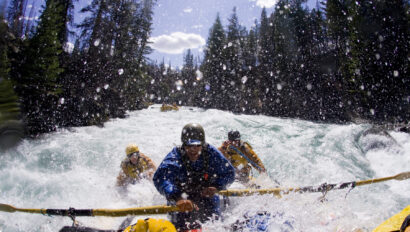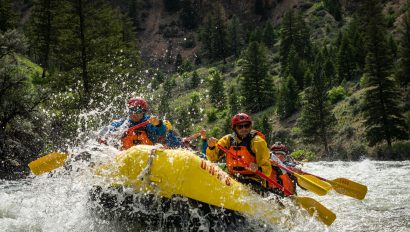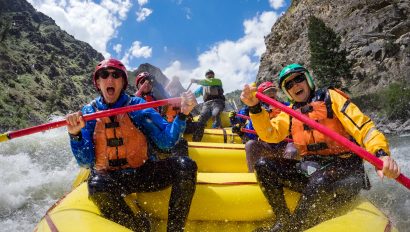2022 Whitewater Outlook: “Low Snowpack” Doesn’t Mean “No Water” for Rafting

Early winter storms, especially in California which received record-breaking snowfall in December, left many people hopeful for a wet 2021/2022 winter out West. However, with very little precipitation and an extremely dry start to the year in many regions, that’s ultimately not what panned out across a large swath of the western U.S.
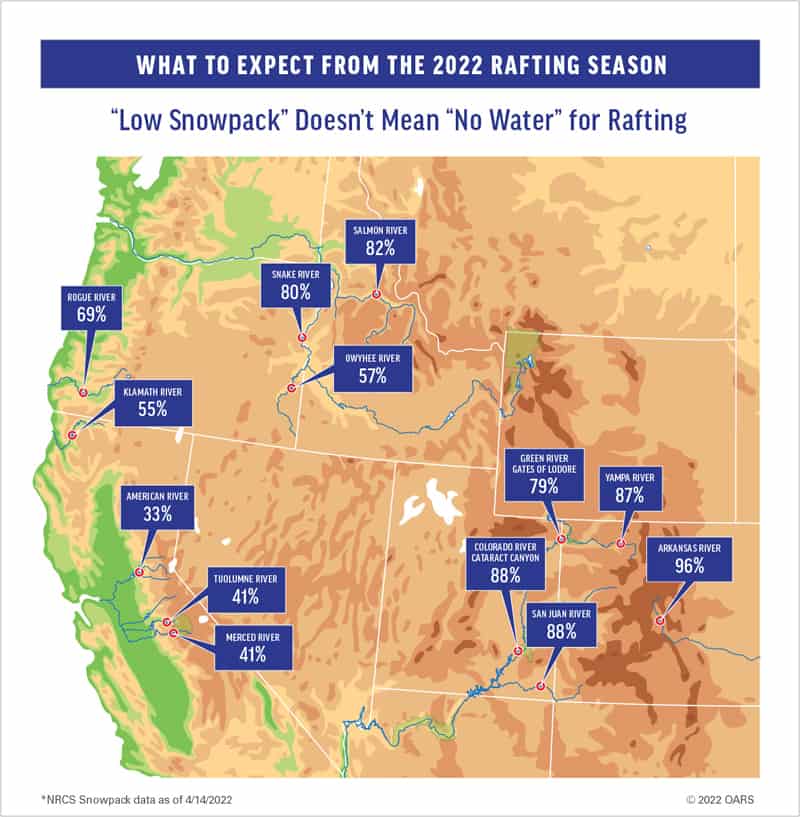
There are some exceptions where the snowpack is near or slightly above the 30-year historical average, like in the Pacific Northwest, northern stretches of Idaho and Montana, as well as some key river basins in Colorado that are measuring near 100% as of the second week of April. There have also been some recent late season storms that are helping boost numbers right now. However, the latest SNOTEL snow survey data still shows a below average snowpack across much of the already drought-stricken region.
Despite what could be interpreted as a lackluster outlook for the 2022 rafting season in the West, there is still plenty of water in many of the major river basins for rafting. Those looking for big, high-water rafting trips, might have to travel outside the lower 48 to Alaska or British Columbia, which received ample snowfall this winter. But similar to last season when snowpack numbers were widely below average across many of the Western states, rafters will still be able to experience reliable, if slightly below average, flows throughout the season on many of the most popular stretches of whitewater in the West.
It’s also important to note that many of the rivers OARS and other outfitters operate on are dam-controlled and rely on scheduled releases from local water agencies which have traditionally been reliable. As drought conditions worsen across the West, and the volatility of the energy market factors into daytime water releases, recreational opportunities on some rivers may become harder to navigate. Outfitters are staying tuned into these conversations, especially in California and Utah, but for now, it’s largely business as usual.
What to Expect During the 2022 Rafting Season
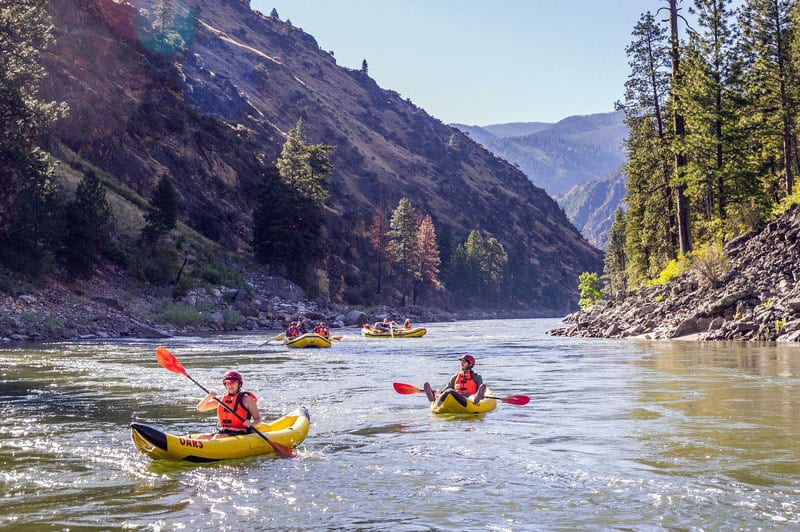
- Similar to 2021, it will be a relatively normal, average water year without too many surprises. Rafters can look forward to fun, low-stress flows throughout the summer on many of the West’s beloved whitewater rivers like Oregon’s Rogue River, Utah’s Green River through the Gates of Lodore, as well as the Colorado River through Cataract Canyon.
- Idaho fared better than much of the West this winter and whitewater classics like the Salmon River and the Snake River through Hells Canyon will offer up solid, but less-intimidating Class III-IV fun for paddlers this season.
- In California, where an extremely dry winter and a dismal statewide snowpack marks three dry years in a row, dam-controlled rivers like the South Fork and Middle Fork of the American River near Sacramento and the Tuolumne River near Yosemite are expected to have reliable flows for rafting Memorial Day through Labor Day, based on water releases from upstream reservoirs. Free-flowing rivers like the Merced near Yosemite and the North Fork of the American, however, will have abbreviated seasons due to the modest snowpack.
- In Colorado, where much of the state is measuring near average, popular rivers like the Arkansas, Gunnison and Upper Animas will be fun options with good flows well into the summer months. But rafters will have to go sooner than later to catch the raftable window for the iconic Yampa in northeastern Colorado where the snowpack was a bit below average compared to the rest of the state.
- Beyond the lower 48, the snowpack in Alaska and British Columbia are well above average right now. Rafters looking for big, epic whitewater experiences this season can look north to legendary river trips like the Tatshenshini and Chilko-Chilcotin-Fraser.
Below, our Operations Managers from around the West share more detailed insights about what to expect from the 2022 rafting season.
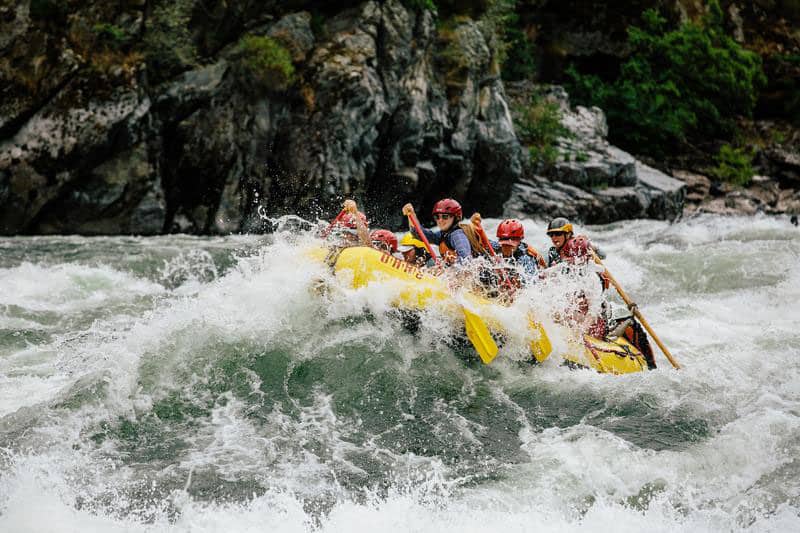
IDAHO
Overall, Idaho’s snowpack fared better than most states in the region by early April, with near average numbers in the Spokane and Clearwater River. Other major river basins like the Salmon and Snake are hovering around 80% of normal.
“Though the snowpack is below average, we have seen worse,” says Curt Chang, OARS Idaho Regional Manager. “Luckily, below average flows still make for a great river trip in Idaho.”
“We always appreciate the lack of super high-water flood issues, but it isn’t over until it’s over,” he adds. “The potential spring wet weather could be a game changer for the good, so fingers crossed.”
Unfortunately, in the southern part of the state, the Owyhee season was practically over before it even started. With a minimal snowpack this winter, early warm weather melted much of what was there too early, according to Hillary Mosman, OARS Idaho Operations Manager. The flow went from 5,000 CFS at the end of March to 750 CFS on April 5, which is below the level for practical rafting conditions.
COLORADO
It’s good news for outfitters this season in Colorado, where the statewide snowpack is measuring 90% of average, and river basins like the Arkansas, Gunnison and Upper Rio Grande River are teetering right around 100% as of early April. Rafters can anticipate a solid rafting season for popular trips like Arkansas River through Browns Canyon or Royal Gorge, Gunnison Gorge, and the Upper Animas.
For the free-flowing Yampa River in northwestern Colorado, where the snowpack is currently at 87% of normal, rafters will want to hop on an early season trip to guarantee the best flows, which are expected to range between 8,000 to 18,000 CFS this season. At this point, early July trips are highly uncertain, and even late June trips are not guaranteed, according to Nicole Lavoie, Dinosaur Operations Manager for OARS. How the weather plays out in April should help provide a better outlook, with cooler conditions and additional precipitation potentially helping lengthen the window for raftable flows and the Yampa season as a whole.
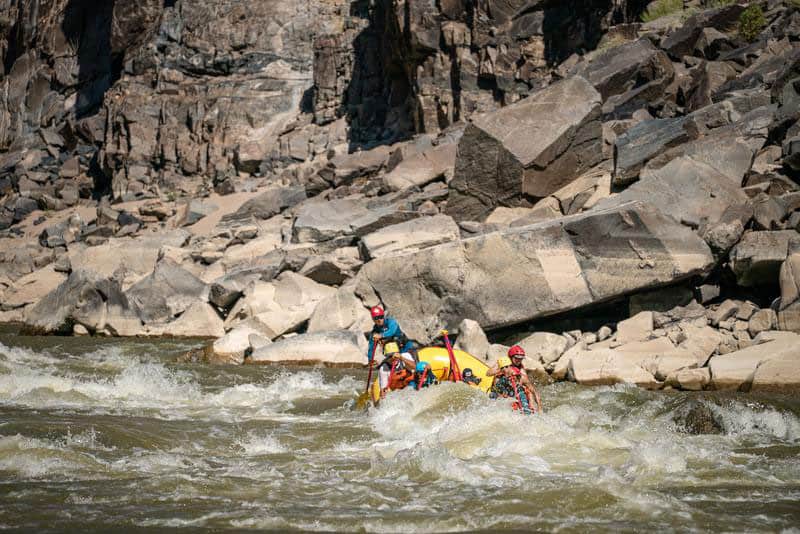
UTAH
Similar to 2021, the snowpack is below average across the state of Utah, but rafting conditions are expected to be slightly better for early season trips based on peak flow predictions.
For the Upper Colorado River Basin above Lake Powell, the snowpack is 88% of normal as of the second week of April, which means lower flows on Colorado River rafting trips in southeastern Utah like Weswater Canyon and Cataract Canyon, especially later in the season.
The one difference for this season based on current conditions is that peak flows are anticipated to be slightly higher than last season, and there is likely to be a bit more water on either side of the peak, according to OARS Operations Director Seth Davis.
“We wouldn’t be surprised to see Westwater get into the high teens for peak water and for Cataract Canyon, we’re anticipating a peak above 30,000 CFS,” he continues.
“Summer and fall flows will still probably be on the lower side of average given a likely smaller input from the Yampa this year,” says Davis. “With that said, ‘low water’ rarely translates to ‘not enough water to raft’ – it’s just a relative reference.”
“High water and low water conditions both have their pros and cons, and no set of conditions is necessarily better,” explains Davis. “The fact the rivers that we run out of Moab still have a wild and free nature to them which is what makes them so appealing – part of what makes an adventure an adventure is not knowing exactly what you’re going to get.”
In the Upper Green River basin, the snowpack measured 79% according to NRCS Snotel data the second week of April. Here, upstream reservoirs like Flaming Gorge Reservoir feed popular whitewater runs like the Green River through Flaming Gorge, Gates of Lodore, and even Desolation Canyon further downstream, which means paddlers can count on rafting into September on these popular trips.
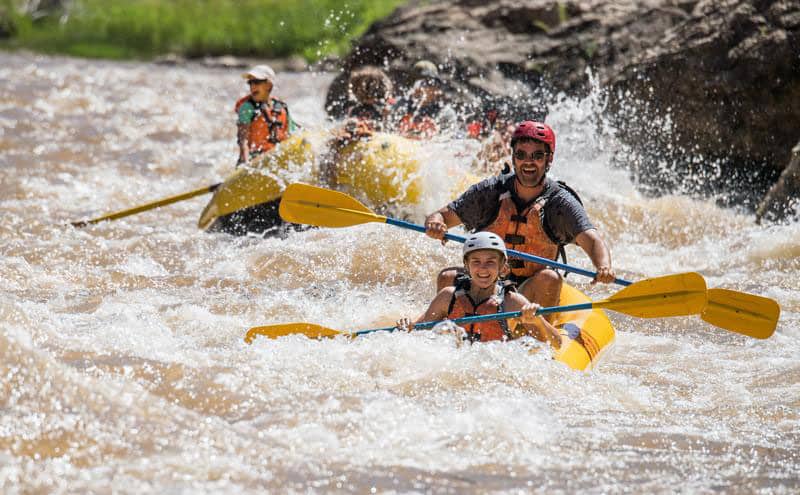
Base flows for the Green River are typically 850-1,800 CFS, but one exciting unknown for rafters this season is the potential for elevated flows in July and August. According to Lavoie, due to extremely low levels in Lake Powell downstream, the Bureau of Reclamation may release additional water from Flaming Gorge Reservoir this summer, which indicates that base flows in July and August could be higher. A number of other factors will dictate when and how much water will be released earlier in the season, so there are many unknowns going into this season that will keep conditions interesting for guides and guests.
The San Juan River basin, where the snowpack is right at 88%, is positive news for rafters. Current conditions suggest rafters will have a better opportunity to experience both the upper and lower sections of this scenic river trip, since more water creates more favorable conditions for running the lower section of the San Juan all the way to the take-out at Clay Hills Crossing.
OREGON
Oregon suffered from an incredibly dry winter and spring, and as a result the statewide snowpack is well below average in most regions, especially in the southern portion of the state.
One exception is the Hood-Lower Deschutes River basin, which is 129% according to NRCS Snotel data the second week of April. Meanwhile, the Rogue River basin is sitting around 69% or normal, while the Klamath is at 55% of normal.
“This means that we can expect lower flows on the Rogue and Lower Klamath for a majority of the season, if not the whole season,” says Dustin Abbott, OARS Oregon Operations Manager. “The good news is that since both rivers are dam-controlled, we can expect ‘raftable’ flows all summer.”
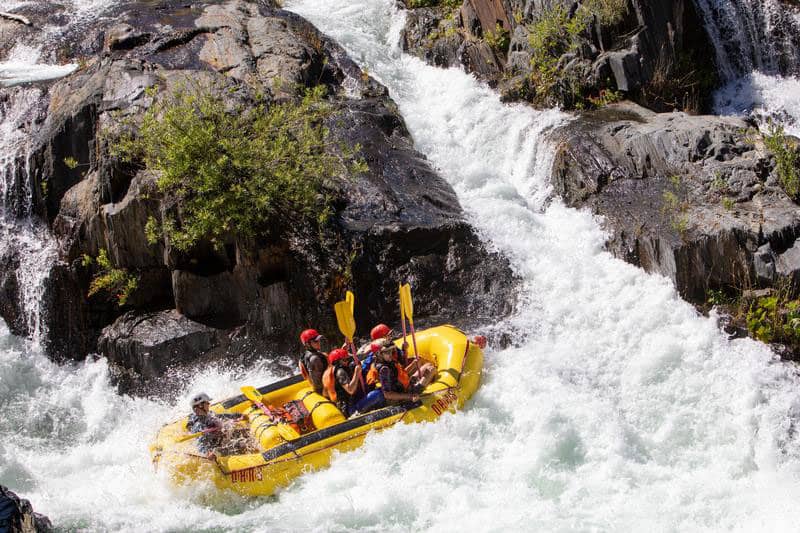
CALIFORNIA
Despite historic snowfall in December, it wasn’t enough to help ongoing drought conditions in California, where the statewide snowpack measured 38% of the historic average during the annual April 1 snow survey conducted by the California Department of Natural Resources.
In the Central Sierra Nevada, the snowpack for the Tuolumne and Merced River basins is slightly higher at 41% of normal for the historic April 1 average, while the American River basin is at 33%. These numbers reflect one of the driest winters in state history, but as usual, rafters can count on some of the Sierra’s most popular and accessible whitewater runs, like the American River near Sacramento and the Tuolumne River near Yosemite, which are dam-controlled and typically provide reliable recreational flows spring through late summer/early fall.
After three dry years in a row, however, outfitters are feeling the impacts of a dry period coupled with a more volatile energy sector that’s putting pressure on local water agencies to release water less frequently or in the evenings when energy demands are high.
On the Tuolumne River, for example, outfitters have traditionally been able to count on day-time water releases six times per week Memorial Day through Labor Day. As of early April, Hetch Hetchy Water and Power has yet to make that determination, so it’s a bit of a wait-and-see game for outfitters right now.
Further north on the American River where the season is already underway on the popular South Fork, OARS California Regional Manager, Jess Wallstrom, says leading into Memorial Day, South Fork American River rafting trips will be available Saturday through Monday. Then, from Memorial Day to Labor Day, trips will be offered five days per week, Thursday through Monday.
On the Middle Fork of the American, availability for trips may be slightly better this year than 2021, according to Wallstrom. At a minimum, outfitters will be able to count on recreational water releases Friday through Sunday, plus Wednesdays, Memorial Day through Labor Day. Outfitters are hopeful for the addition of water releases on Thursdays, as well, which would increase the number of trip offerings compared to last season.
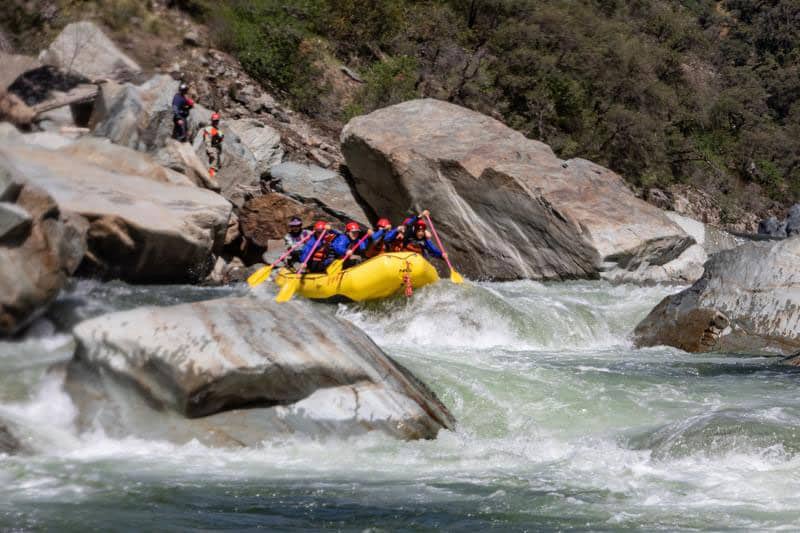
Right now, rafters can catch some of California’s free-flowing rivers, which rely completely on runoff and offer some of the state’s best spring rafting opportunities. The window for trips on the North Fork of the American River will be short-lived, according to Wallstrom, but she anticipates several more weeks of raftable water in April.
Similarly, on the free-flowing Merced River near Yosemite, Wallstrom is expecting raftable flows in the 2,000-3,000 CFS range for the next several weeks, and trips to run through May.
GRAND CANYON
The water that flows through Grand Canyon comes from releases from Lake Powell’s Glen Canyon Dam. With record low water levels in Lake Powell, there’s not as much to release. Similar to many dam-controlled flows across the West, this spring, summer and fall are not expected to be marked by giant flows in Grand Canyon.
“Since we’re dam controlled, our numbers are based more on the level of Reservoir Powell,” says OARS Grand Canyon Operations Manager, Lars Haarr. “And based on the fact that it currently sits at the lowest water level since it began to fill, we’ll likely see somewhat lower flows this season.”
“This typically means a change in the character of some rapids, but still fun whitewater,” he adds.
Still, the upside of dam-controlled releases is they’re consistent. The complex bureaucracy surrounding Lake Powell and the reservoir at the end of Grand Canyon, Lake Mead, dictate that a certain amount of water must be released from Glen Canyon.
“Water levels in Grand Canyon also fluctuate depending on power-generation needs. April, May, September and October are typically lower, then flows ramp up for June, July, and August when hot weather causes a big increase in electricity needs,” Haarr says.
Though it might not be a big water year, the rapids on a Grand Canyon rafting trip are always world-class.
Photos: Main Salmon rafting – James Kaiser; Snake River rafting through Hells Canyon – Andrew Miller; Colorado River rafting through Westwater Canyon – Rob Aseltine; Gates of Lodore rafting – Josh Miller; California rafting on the Middle Fork of the American – Dylan Silver; Rafters on North Fork of the American River 2022 rafting season – Dylan Silver
Resources:
NRCS Idaho Snowpack Update SNOTEL Report
NRCS Oregon SNOTEL Snow/Precipitation Update Report
NRCS Upper Colorado River Snow/Precipitation Update Report
NRCS Colorado SNOTEL Snowpack Update Report
NRCS Westwide SNOTEL Current Snow Water Equivalent
California Department of Natural Resources Snow Course Measurements for April 2022
Related Posts
Sign up for Our Newsletter

